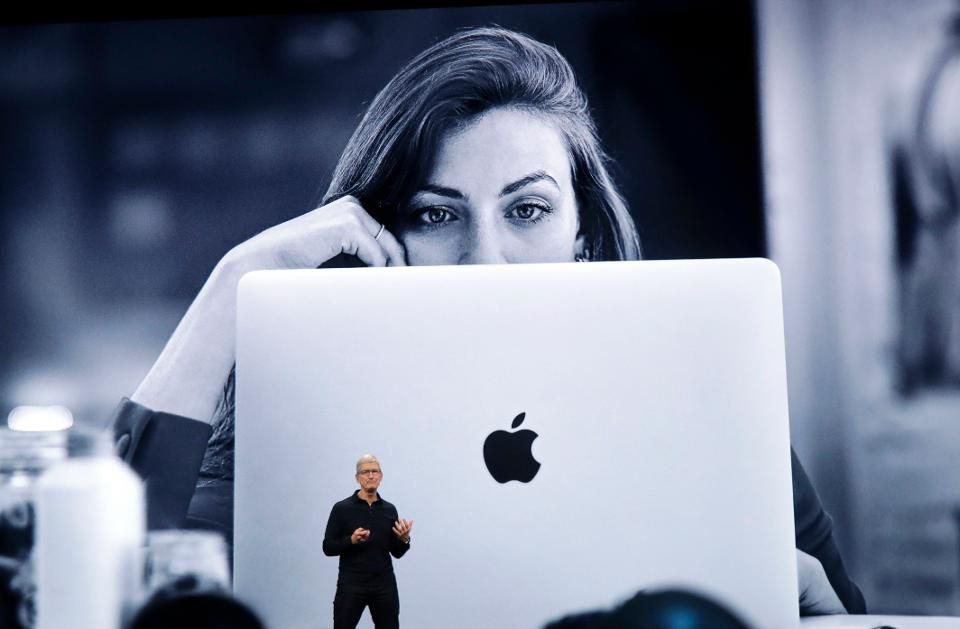Once upon a time, Apple asked you to “Think Different”… Once upon a time, Apple supported untold unique voices with different ways to use its personal computer… Once upon a time Apple launched one of the most influential laptops of all time in the MacBook Pro.
That time is now consigned to the history books. As Apple moves forward, it believes that Steve Jobs’ vision belongs in the past. That MacBook Pro is dead. It’s Tim Cook’s rodeo now, and there’s a new flavor of MacBook Pro in town.
![Apple CEO Tim Cook speaks at the Apple Worldwide Developers Conference in San Jose, Calif., Monday,... [+] June 3, 2019. (AP Photo/Jeff Chiu)](https://thumbor.forbes.com/thumbor/960x0/https%3A%2F%2Fspecials-images.forbesimg.com%2Fdam%2Fimageserve%2F96f0e398179c4a769352c5a5e33a943c%2F960x0.jpg%3Ffit%3Dscale)
Apple CEO Tim Cook speaks at the Apple Worldwide Developers Conference in San Jose, Calif., Monday,… [+]
Apple’s current frame of reference is that it wants to not only push forward, but to pull its audience forward with it. This has created a relentless pace of updates, both in software and hardware. Keeping up with all of these changes can be a full time job. Tim Cook’s assumption is that Apple’s users want the best and only his team can offer that. So that means a hardware updates to squeeze every bit of potential from the future, and software updates that take advantage of the new hardware while culling away older features that are no longer ‘on mission’.
Taking a high-level view, it’s clear that one belief is that mobile devices have had priority in Apple’s thinking. The rise of the iPhone in popular culture is testament to that, but in the iPad Apple managed to launch one of the few massively successful tablets built around a mobile-focused OS.
As the iPhone (and Android) rose up from the ashes of Symbian, Palm, and Windows Mobile, it needed a companion that could support it. From moving music and files, to backing up user data and allowing those all important software updates to be delivered, Steve Jobs’ iPhone needed a powerful partner.
And that partner was the MacBook Pro.
![A man walks into an Apple store in Beijing. Apple on Tuesday, May 19, 2015 introduced an updated... [+] MacBook Pro and iMac and lowering the price for its top-end iMac (AP Photo/Andy Wong, File)](https://thumbor.forbes.com/thumbor/960x0/https%3A%2F%2Fspecials-images.forbesimg.com%2Fdam%2Fimageserve%2Fcbaf3a0b0e6b44dea1bf774e75d0c8da%2F960x0.jpg%3Ffit%3Dscale)
A man walks into an Apple store in Beijing. Apple on Tuesday, May 19, 2015 introduced an updated… [+]
Not only did the laptop offer everything that a consumer needed to make the iPhone sing, it was also the perfect tool to develop the all-important applications that would allow the smartphone platform to flourish. The iPhone was your mobile device suited for light work and entertainment, with the power and creativity on tap in the MacBook Pro back home.
They were Butch and Sundance, they were Lennon and McCartney, they were Hitchcock and Scully.
![The new Apple iPhone 11 was on display during an event to announce new products Tuesday, Sept. 10,... [+] 2019, in Cupertino, Calif. (AP Photo/Tony Avelar)](https://thumbor.forbes.com/thumbor/960x0/https%3A%2F%2Fspecials-images.forbesimg.com%2Fdam%2Fimageserve%2F1cb3946c8cd641d5a34f28a6893af1ec%2F960x0.jpg%3Ffit%3Dscale)
The new Apple iPhone 11 was on display during an event to announce new products Tuesday, Sept. 10,… [+]
Then the iPhone started to take over in terms of sales and revenue. The role of the MacBook Pro began to change, and newly installed CEO Tim Cook made a choice. Mobile was the priority. The MacBook Pro was still a vital tool for Apple developers, but the shiny iPhone was the new world. Its Silicon Valley styled corporate interests could not ignore the growth of the iPhone both in unit sales and revenue being reported back to Cupertino.
Here was one of Cook’s significant decision. Back both flagship products, or allow one to have primacy?
With the benefit of hindsight, it is clear that the iPhone stayed in the majors, while the MacBook Pro was sent down to the minors. The iPhone had a new companion, and it was called ‘the cloud’. Cook set about building Apple’s stronghold in the sky. Apple Music first lifted iTunes away from the desktop silo model to cloud-based storage, and then to a full streaming service. Office documents and online storage joined the media in the cloud, and the delights of recurring revenue helped boost the average revenue per user. No longer was Apple tied to unit sales, it could continue to generate revenue over the lifetime of a device.
But what of the MacBook Pro?
![A guest looks at the Touch Bar on a MacBook computer shown in a demo room following the announcement... [+] of new products at Apple headquarters, in Cupertino, Calif, (AP Photo/Marcio Jose Sanchez, File)](https://thumbor.forbes.com/thumbor/960x0/https%3A%2F%2Fspecials-images.forbesimg.com%2Fdam%2Fimageserve%2F67bf7da675b14a469dbdc06c06241739%2F960x0.jpg%3Ffit%3Dscale)
A guest looks at the Touch Bar on a MacBook computer shown in a demo room following the announcement… [+]
In essence, the full feature set of the standalone MacBook Pro of Steve Jobs was no longer needed. While a desk-bound solution was still preferred for developers, media creatives, and other roles needing large screens, physical keyboards, and computing power, a laptop for the ‘smartphone first’ generation growing up with the iPhone would need to have different design goals.
These laptops begin to focus on being thin and lightweight, they needed to be fashionable, and they needed to work with the information that was stored in the cloud. Just as the modern iPhone requires connectivity (or a frequent connection to refresh the cached data) to work, the macOS family changed to follow that same goal. In essence the MacBook Pro has evolved from a standalone computer into a wannabe super-sized smartphone with a hinge and a physical keyboard.
![The Touch Bar is seen on a new MacBook Pro laptop computer during an event at Apple Inc.... [+] headquarters in Cupertino (Photographer: David Paul Morris/Bloomberg)](https://thumbor.forbes.com/thumbor/960x0/https%3A%2F%2Fspecials-images.forbesimg.com%2Fdam%2Fimageserve%2F39477064%2F960x0.jpg%3Ffit%3Dscale)
The Touch Bar is seen on a new MacBook Pro laptop computer during an event at Apple Inc.… [+]
© 2016 BLOOMBERG FINANCE LP
The recent public release of MacOS Catalina is one of the last major steps down this road. It ties the MacBook Pro (and the rest of the Mac family) tightly into Apple’s cloud based services, notably with the new Music, TV, and Podcast apps. The ability to run a number of iPadOS apps makes it clear that the device is still seen as a Minor League player, but one that still needs to be available for certain parts of Apple’s ecosystem.
This is Tim Cook’s MacBook Pro. At its heart, it is a device that supports Apple’s future vision of streaming media and cloud based services, all generating revenue through user subscriptions to these services. It is a financial model that is echoed by many in Silicon Valley.
Arguably the iPhone and the iPad are following the exact same business model, with the implicit assumption that Apple’s hardware is little more than a key to access the online revenue-generating services. That’s a vision that many of those living on the cutting edge of online innovation are happy with, but it does leave others behind.
Pair up Cook’s view of ‘everything is online’ with Apple’s fascination of driving consumers forward through rapid software and hardware updates – it makes corporate sense that the MacBook Pro of yesteryear is no more and understandable that the MacBook Pro of today is a different beast.
“Think different” is no more. Just “Think the same way” as Apple about the MacBook Pro and everything will be fine.
[“source=forbes”]




